Published in London & New York
10 Queen Street Place, London
1345 Avenue of the Americas, New York
Creditflux is an
company
© Creditflux Ltd 2024. All rights reserved. Available by subscription only.


News
Competition for deals and rising rates encourage greater use of PIK clauses
by Lisa Fu
Despite improving conditions in credit, the number of private credit deals paying payment-in-kind (PIK) interest is staying at high levels — but the drivers are changing. The latest data for business development companies, a proxy for the rest of the opaque direct lending universe, showed PIK income remained at 9% in the second quarter, as more lenders offered companies the option to defer payment.
PIK, where some or all cash payments are delayed and amortised to the loan’s principal, increased as a portion of BDC income from 4.1% in 2019 to 6.8% in 2020. PIK income then jumped in 2020 due to the impact of the pandemic, as underperforming borrowers amended existing loans. It continues to tick up even in 2024.
Now, most PIK is offered from day one when structuring new deals, said Chelsea Richardson, a senior director for non-bank financial institutions at Fitch.
The 9% PIK income figure is an average of public BDCs. Some have a materially higher PIK concentration. S&P Global Ratings notably downgraded its outlook on the Prospect Capital Corp BDC to “negative” in September, citing PIK income of 15.6%, along with concentrated exposures to struggling investments.


PIK is becoming more common in upper middle market deals
Dean D’Angelo
Co-head of private credit
Stellus Capital Management
“Our expectation was that [PIK interest] would come back down as [pandemic-related challenges] played out, but we have instead seen PIK continue to rise,” said Richardson. “I think that’s a result of the competitive underwriting dynamics and the high interest rate environment.”
No lender wants to offer PIK, said Dean D’Angelo, co-head of private credit at Stellus Capital Management, a lower middle market lender. While PIK is not a part of initial capital structures for PE-backed lower middle market deals, it is becoming more common in upper middle market deals as sponsors look to maximise leverage.
Competition for deals among direct lenders in the upper middle market is intense, driving lenders to offer PIK or a PIK toggle at origination to win a deal, he said.
More borrowers have also used PIK over the past year and a half, since the Fed began hiking rates, Richardson said. Borrowers prefer to defer payments rather than allowing costly debt servicing to eat away at cashflow.





